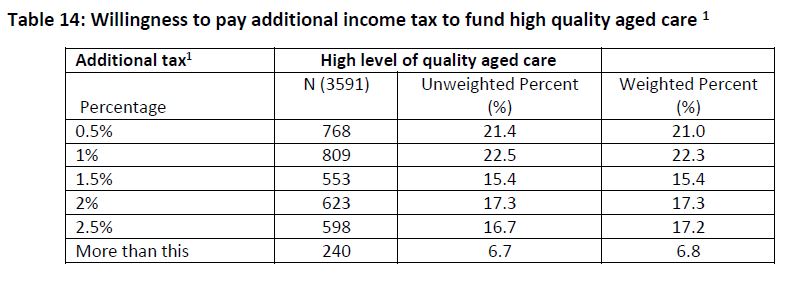Australians are willing to pay more to ensure access to better-quality aged care, according to a survey of 10,000 people outside of the aged care system by Flinders University commissioned by the Royal Commission.
The Commission’s sixth 80-page research paper – ‘Australia’s aged care system: assessing the views and preferences of the general public for quality of care and future funding’ – released today details the results of the online survey of 10,315 adults aged 18 to 91 years not currently using aged care services.
You can download the paper on the Royal Commission’s website here.
Most Australians think Government should provide higher aged care funding
Of the respondents, two thirds (67%) said they had at least some understanding of the system while 33% said they had none.
The research found 87% of the respondents agreed that the Government should provide more funding for aged care services.
The Government currently allocates around 4% of income tax collected to aged care. 59% of those surveyed said this should be raised to around 8% on average (mean 8.6%, median 8%) – doubling the current proportion of taxpayers’ dollars allocated.
Another 9% disagreed and 31% were uncertain – perhaps indicating a lack of knowledge about what this would mean.
Australians say they would support tax increase
Two-third of those survey were taxpayers, with 61% of those indicating they would be willing to pay more income tax (in a form such as the Commission’s proposal for a Medicare-style levy) to support a quality aged care system.
On average, current income taxpayers said they would be willing to pay an additional 1.4% income tax per year, plus another 1.7% per year (for a total rise of 3.1%) to achieve high quality aged care (the Royal Commission’s recent financing consultation paper has proposed a 1% or 2% increase in income taxes to fund the system).

People willing to pay make higher co-contributions?
80% of respondents also said they would be willing to make co-contribution payments if they needed to access aged care services in the future.
Unsurprisingly, the 22% of people with current experience of the aged care system through a close family member were willing to pay a higher co-contribution than those without current experience.
As you would expect, those respondents with higher income levels were also generally willing to pay more to access aged care services than those reporting lower income levels.
Respondents say they would shell out $10K a year to stay at home
People were also keen to stay at home with 72% saying they would be willing to pay a larger co-contribution to receive the support they need to age in place rather than enter residential care – an average co-contribution of $184 per week (around $9,568 per year).
On average, respondents said they would pay $162.52 per week to receive a ‘satisfactory level of quality’ home care and $240.95 per week to receive a ‘high level of quality’ home care (amounting to an additional quality payment of $78 per week or 48%). Currently, co-contributions for home care are around $30 a week according to the Royal Commission.
If people had to move into residential care, the average willingness to pay co-contribution amounts jumped to $528.75 per week to receive a ‘satisfactory level of quality’ residential care and $693.11 per week to receive a ‘high level of quality’ residential care (amounting to an additional quality payment of $164 per week or 31%).
Older people understand need to co-contribute
Respondents with current experience were again willing to pay more than those without current experience – a co-contribution of $580.85 per week to receive satisfactory level of quality residential care and $769.32 per week to receive a high level of quality residential care (representing to an additional quality premium fee of $188 per week or 32%).
This also varied by quality rating and by age group. Younger people who showed a willingness to co-contribute were more likely on average to indicate higher co-contribution amounts overall.
However, higher numbers of older people were more accepting of the need to co-contribute – particularly at the lower levels – to access satisfactory and high levels of quality home care respectively compared to younger people.
Staffing and ability to complain more important than choice
People also had firm ideas about what they want from their aged care or home care provider – namely, being treated with respect and dignity, staff having the skills and training needed to provide care and supports for daily living that help with their health and wellbeing (is that a vote for the Royal Commission’s wellness and reablement approach?)
Respondents also rated the ability to lodge complaints with their chosen provider as a key indicator for quality i.e. providers showing that they actually take feedback and address issues were rated more highly.
Interestingly, being supported to make your own decisions – a central part of Consumer-Directed Care in home care – was seen as less important.
Some respondents unlikely to have understanding of system
The Commissioners, Tony Pagone QC and Lynelle Briggs AO, say the research confirms Australians want high quality aged care to be delivered and accept that more funding is part of the solution.
“It shows the general public recognise the current deficiencies of Australia’s aged care system and believe significantly more government funding should be allocated to achieve higher quality aged care, in addition to using co-contributions based on care recipient’s capacity to contribute,” they conclude. “It shows a majority of current income taxpayers would be willing to pay more income tax to ensure a high-quality aged care system is achieved.”
However, there are a few caveats. The paper qualifies that some of the respondents were younger, and less likely to have any familiarity with Australia’s aged care system, their projected future income levels or their ability to pay co-contribution fees to access aged care services into the future.
While the sample was weighted to represent the Australian population in terms of age, gender and state or territory, it was also online so excluded those who are not computer literate.
Little understanding of costs among public and Government
It is also one thing to tick a box on an online survey and another to actually pay out the cash.
Are Australians really prepared to see their taxes go up or pay hundreds of dollars extra a week for care?
The paper omits two key points that have come out of the Royal Commission so far regarding paying for aged care: firstly, that the public as a whole has little understanding of the real costs of providing care, and secondly, that the Department of Health has no data on the actual costs of delivering care services.
Both are issues that will need to be dealt with before Australians are likely to open their pockets.










